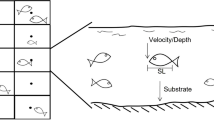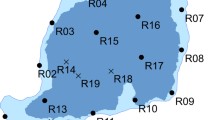Abstract
Ecological trade-offs by organisms to minimize mortality and maximize growth is a foundational theme in ecology. Yet, these trade-offs are rarely examined within spatially complex, temporally variable ecosystems, such as floodplain rivers. Here, we evaluate ecological trade-offs across space and time for the bluegill (Lepomis macrochirus) in two unregulated river ecosystems in southeastern USA. Life-history differences among spatially segregated main channel and floodplain lake populations were used to assess effects of habitat type on bluegill fitness. Growth, condition, and gonadal somatic index were all significantly enhanced in floodplain lakes relative to the main channel. Furthermore, stomach fullness was significantly higher, and predator densities significantly lower in floodplain lakes thereby providing an ecological explanation for the life-history plasticity observed across the riverscape. However, historical observations suggested that although floodplain lakes are highly productive for bluegills, they are also prone to complete desiccation by drought approximately every 5 years, revealing the ultimate value of channel habitat, which does not dry, as desiccation refugia. Bluegills are faced with a balancing act associated with variation in foraging opportunities, and risks to predation and desiccation, that change in both the temporal and the spatial dimensions of floodplain rivers. The differential responses to these opportunities and risks help to explain why both habitats remain actively populated by bluegills, as well as many other organisms, in these and many other natural rivers.




Similar content being viewed by others
References
Benke AC, Chaubey I, Ward GM, Dunn EL. 2000. Flood pulse dynamics of an unregulated river floodplain in the southeastern US coastal plain. Ecology 81:2730–41.
Blanckenhorn WU. 2000. The evolution of body size: what keeps organisms small? Q Rev Biol 75:385–407.
Costanza R et al. 1997. The value of the world’s ecosystem services and natural capital. Nature 387:253–60.
Dickman CR. 1992. Predation and habitat shift in the house mouse, Mus domesticus. Ecology 73:313–22.
Fausch KD, Torgersen CE, Baxter CV, Li HW. 2002. Landscapes to riverscapes: bridging the gap between research and conservation of stream fishes. Bioscience 52:483–98.
Godvik IMG, Loe LE, Vik JO, Velberg V, Langvatn R, Mysterud A. 2009. Temporal scales, trade-offs, and functional responses in red deer habitat selection. Ecology 90:699–710.
Grol MGG, Nagelkerken I, Rypel AL, Layman CA. 2011. Simple ecological trade-offs give rise to emergent cross-ecosystem distributions of a coral reef fish. Oecologia 165:79–88.
Harrold C, Reed DC. 1985. Food availability, sea-urchin grazing, and kelp forest community structure. Ecology 66:1160–9.
Junk WJ, Bayley PB, Sparks RE. 1989. The flood pulse concept in river-floodplain systems. In: Dodge DP, Ed. Proceedings of the international large river symposium, vol 106. Canadian Special Publication in Fisheries and Aquatic Sciences, pp 110–27.
Kennedy TB. 2009. Aquatic community organization in a diverse floodplain river fish Fauna of the Southeastern United States. In: The University of Alabama, Tuscaloosa, AL, p 257.
Kimura D. 1980. Likelihood methods for the von Bertalanffy growth curve. Fish Bull 77:765–76.
Komdeur J, Daan S, Tinbergen J, Mateman C. 1997. Extreme adaptive modification in sex ratio of the Seychelles warbler’s eggs. Nature 385:522–5.
Langerhans RB, Layman CA, Langerhans AK, Dewitt TJ. 2003. Habitat-associated morphological divergence in two Neotropical fish species. Biol J Linn Soc 80:689–98.
Langerhans RB, Layman CA, Shokrollahi AM, DeWitt TJ. 2004. Predator-driven phenotypic diversification in Gambusia affinis. Evolution 58:2305–18.
Layman CA, Langerhans RB, Winemiller KO. 2005. Body size, not other morphological traits, characterizes cascading effects in fish assemblage composition following commercial netting. Can J Fish Aquat Sci 62:2802–10.
Lima SL. 1985. Maximizing feeding efficiency and minimizing time exposed to predators: a trade-off in the black-capped chickadee. Oecologia 66:60–7.
Lima SL. 1998. Stress and decision making under the risk of predation: recent developments from behavioral, reproductive, and ecological perspectives. Adv Stud Behav 27:215–90.
Lima SL, Zollner PA. 1996. Towards a behavioral ecology of ecological landscapes. Trends Ecol Evol 11:131–5.
Martin K, Eadie JM. 1999. Nest webs: a community-wide approach to the management and conservation of cavity-nesting forest birds. For Ecol Manag 115:243–57.
Meschiatti AJ, Arcifa MS, Fenerich-Verani N. 2000. Fish communities associated with macrophytes in Brazilian floodplain lakes. Environ Biol Fishes 58:133–43.
Pianka ER. 1974. Evolutionary ecology. New York: Harper and Row.
Poff NL et al. 1997. The natural flow regime. Bioscience 47:769–84.
Ricker WE. 1975. Computation and interpretation of biological statistics of fish populations. Fish. Res. B. Can. 191:382.
Riddell BE, Leggett WC. 1981. Evidence of an adaptive basis for geographic variation in body morphology and time of downstream migration of juvenile Atlantic salmon (Salmo salar). Can J Fish Aquat Sci 38:308–20.
Rood SB, Goater LA, Mahoney JM, Pearce CM, Smith DG. 2007. Floods, fire, and ice: disturbance ecology of riparian cottonwoods. The review is one of a selection of papers published in the Special Issue on Poplar Research in Canada. Can J Bot 85:1019–32.
Rypel AL. 2007. Sexual dimorphism in growth of freshwater drum. Southeast Nat 6:333–42.
Rypel AL. 2008. Long-term growth variations of diverse taxa from two Southeastern Coastal Plain Rivers. Tuscaloosa, AL: The University of Alabama. p 158.
Rypel AL, Layman CA, Arrington DA. 2007. Water depth modifies relative predation risk for a motile fish taxa in Bahamian tidal creeks. Estuar Coast 30:518–25.
Sabo MJ, Kelso WE. 1991. Relationship between morphometry of excavated floodplain ponds along the Mississippi River and their use as fish nurseries. Trans Am Fish Soc 120:552–61.
Sabo JL, Post DM. 2008. Quantifying periodic, stochastic, and catastrophic environmental variation. Ecol Monogr 78:19–40.
Saper CB, Chou TC, Elmquist JK. 2002. The need to feed: homeostatic and hedonic control of eating. Neuron 36:199–211.
Schindler DE et al. 2010. Population diversity and the portfolio effect in an exploited species. Nature 465:609–12.
Schlosser IJ. 1990. Environmental variation, life history attributes, and community structure in stream fishes: Implications for environmental management and assessment. Environ Manag 14:621–8.
Schlosser IJ. 1991. Stream fish ecology: a landscape perspective. Bioscience 41:704–12.
Sih A, Kats LB, Moore RD. 1992. Effects of predatory sunfish on the density, drift, and refuge use of stream salamander larvae. Ecology 73:1418–30.
Slipke JW, Sammons SM, Maceina MJ. 2005. Importance of connectivity of backwater areas for fish production in Demopolis Reservoir, Alabama. J Freshw Ecol 20:479–85.
Sousa RGC, Freitas CED. 2008. The influence of flood pulse on fish communities of floodplain canals in the Middle Solimoes River, Brazil. Neotrop Ichthyol 6:249–55.
Taylor EB, McPhail JD. 1985. Variation in burst and prolonged swimming performance among British Columbia populations of coho salmon, Oncorhynchus kisutch. Can J Fish Aquat Sci 42:2029–33.
Vanni MJ. 1987. Effects of food availability and fish predation on a zooplankton community. Ecol Monogr 57:61–88.
Walters S. 2001. Landscape pattern and productivity effects on source-sink dynamics of deer populations. Ecol Model 143:17–32.
Ward GM, Harris PM, Ward AK. 2005. Gulf coast rivers of the Southeastern United States. In: Benke AC, Cushing CE, Eds. Rivers of North America. Amsterdam: Elsevier. p 125–78.
Wellborn GA, Skelly DK, Werner EE. 1996. Mechanisms creating community structure across a freshwater habitat gradient. Annu Rev Ecol Syst 27:337–63.
Werner EE, Hall DJ. 1988. Ontogenetic habitat shifts in bluegill: the foraging rate predation risk trade-off. Ecology 69:1352–66.
Werner EE, McPeek MA. 1994. Direct and indirect effects of predators on 2 Anuran species along an environmental gradient. Ecology 75:1368–82.
Wiens JA. 2002. Riverine landscapes: taking landscape ecology into the water. Freshw Biol 47:501–15.
Acknowledgments
We thank B. Comeens, B. Price, B. O’Shields, S. Kone, and J. Rypel for field and laboratory assistance. This research was supported by the UA Department of Biological Sciences, the J. Nicholene Bishop Professorship of Biology (RHF), a National Alumni License Tag Fellowship and Graduate Research Fellowship (ALR), and an Alabama Academy of Science grant (ALR).
Author information
Authors and Affiliations
Corresponding author
Additional information
Author contributions
A.L. Rypel conceived the study, performed research, analyzed data and wrote the paper; R.H. Findlay helped conceive the study and write the paper; K. Pounds performed research, analyzed data and helped write the paper.
Rights and permissions
About this article
Cite this article
Rypel, A.L., Pounds, K.M. & Findlay, R.H. Spatial and Temporal Trade-Offs by Bluegills in Floodplain River Ecosystems. Ecosystems 15, 555–563 (2012). https://doi.org/10.1007/s10021-012-9528-0
Received:
Accepted:
Published:
Issue Date:
DOI: https://doi.org/10.1007/s10021-012-9528-0




